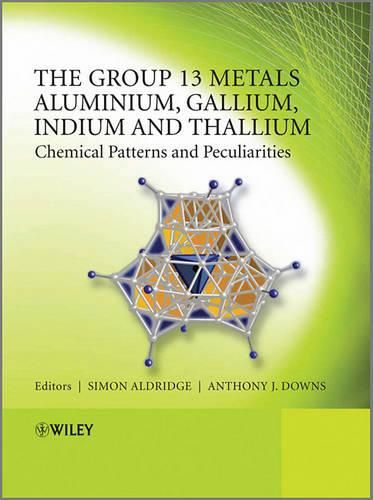Readings Newsletter
Become a Readings Member to make your shopping experience even easier.
Sign in or sign up for free!
You’re not far away from qualifying for FREE standard shipping within Australia
You’ve qualified for FREE standard shipping within Australia
The cart is loading…






The last two decades have seen a renaissance in interest in the chemistry of the main group elements. In particular research on the metals of group 13 (aluminium, gallium, indium and thallium) has led to the synthesis and isolation of some very novel and unusual molecules, with implications for organometallic synthesis, new materials development, and with biological, medical and, environmental relevance. The Chemistry of the Group 13 Metals: Aluminium, Gallium, Indium and Thallium aims to cover new facts, developments and applications in the context of more general patterns of physical and chemical behaviour. Particular attention is paid to the main growth areas, including the chemistry of lower formal oxidation states, cluster chemistry, the investigation of solid oxides and hydroxides, advances in the formation of III-V and related compounds, the biological significance of Group 13 metal complexes, and the growing importance of the metals and their compounds in the mediation of organic reactions. Chapters of this title cover: general features of the group 13 elements; group 13 metals in the +3 oxidation state - simple inorganic compounds; formal oxidation state +3 - organometallic chemistry; formal oxidation state +2 - metal-metal bonded vs. mononuclear derivatives; group 13 metals in the +1 oxidation state; mixed or intermediate valence group 13 metal compounds; aluminium and gallium clusters - metalloid clusters and their relation to the bulk phases, to naked clusters, and to nanoscaled materials; simple and mixed metal oxides and hydroxides - solids with extended structures of different dimensionalities and porosities; coordination and solution chemistry of the metals - biological, medical and, environmental relevance; III-V and related semiconductor materials; and, group 13 metal-mediated organic reactions. The Chemistry of the Group 13 Metals: Aluminium, Gallium, Indium and Thallium provides a detailed, wide-ranging, and up-to-date review of the chemistry of this important group of metals. It will find a place on the bookshelves of practitioners, researchers and students working in inorganic, organometallic, and materials chemistry.
$9.00 standard shipping within Australia
FREE standard shipping within Australia for orders over $100.00
Express & International shipping calculated at checkout
The last two decades have seen a renaissance in interest in the chemistry of the main group elements. In particular research on the metals of group 13 (aluminium, gallium, indium and thallium) has led to the synthesis and isolation of some very novel and unusual molecules, with implications for organometallic synthesis, new materials development, and with biological, medical and, environmental relevance. The Chemistry of the Group 13 Metals: Aluminium, Gallium, Indium and Thallium aims to cover new facts, developments and applications in the context of more general patterns of physical and chemical behaviour. Particular attention is paid to the main growth areas, including the chemistry of lower formal oxidation states, cluster chemistry, the investigation of solid oxides and hydroxides, advances in the formation of III-V and related compounds, the biological significance of Group 13 metal complexes, and the growing importance of the metals and their compounds in the mediation of organic reactions. Chapters of this title cover: general features of the group 13 elements; group 13 metals in the +3 oxidation state - simple inorganic compounds; formal oxidation state +3 - organometallic chemistry; formal oxidation state +2 - metal-metal bonded vs. mononuclear derivatives; group 13 metals in the +1 oxidation state; mixed or intermediate valence group 13 metal compounds; aluminium and gallium clusters - metalloid clusters and their relation to the bulk phases, to naked clusters, and to nanoscaled materials; simple and mixed metal oxides and hydroxides - solids with extended structures of different dimensionalities and porosities; coordination and solution chemistry of the metals - biological, medical and, environmental relevance; III-V and related semiconductor materials; and, group 13 metal-mediated organic reactions. The Chemistry of the Group 13 Metals: Aluminium, Gallium, Indium and Thallium provides a detailed, wide-ranging, and up-to-date review of the chemistry of this important group of metals. It will find a place on the bookshelves of practitioners, researchers and students working in inorganic, organometallic, and materials chemistry.